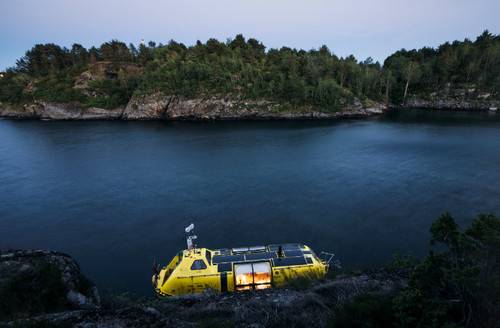Lifeboat Converted Into Unsinkable Solar-Powered Arctic Excursion Boat

A new solar vessel that can theoretically be submerged and remain unharmed has been produced by repurposing a lifeboat that could originally accommodate 100 people.
Two British architects, Guylee Simmonds and David Schnabel, recognized that the craft could be converted into an adventure vessel that could explore the Norwegian Artic while offering its occupants all the comforts of home.
“We wanted to experience a range of different cultures, different approaches to living by the sea, different landscapes, different climates. And if you are creating an expedition boat that will take you 3100 miles up the Norwegian coast, your concerns include a bit more of the finer things in life,” they stated.
The ideas that the architect applied throughout the project were informed by their experience in designing buildings, their objective being to capture the views and bring the outside in while at the same time keeping the Arctic conditions out. One of the main conversions to the boat, which is named Stodig, was to cut into its back to create a deck. They also made a wood burner the focal point of the interior space to give plenty of heat and they built a seating area that faced a friendly-sized kitchen. They then added a large bathroom, two staterooms and two bunk beds for guests.
The vessel’s windows are a key feature: “We have an incredibly light living space with big panoramic views out either side of the boat. It allows us to experience the majesty of the fjords and the mountains in a way that you rarely ever get to inside of another boat,” Simmonds and Schnabel explained. They built the windows to afford an expansive view, and for ventilation decided to have the lower section of the boat open and close on demand. Water and weather are excluded by means of rubber gaskets.
One of the key innovative features of the vessel is its Sunflare solar-powered system which fuels its operation and allows it to run for long periods totally off the grid: the boat has 900 watts of solar power and two 12-volt batteries on board. One battery is for starting the engine and for cruising, navigation, and winch operation while the second acts as a domestic bank, supplying 660 amp hours of electricity powering the refrigerator, the composting toilet, the toaster, the kettle, the power tools, and the crew’s laptops. Stodig is 33 feet long, 3.5 feet wide and has about 6.5 feet of headroom. The fiberglass of the boat is twice as thick as that of a normal pleasure boat and the builders stated that the vessel is unsinkable: the boat is designed to be able to roll over and roll back up to the surface when fully sealed.
The boat’s first planned excursion, which will cover from 2200 up to 3100 miles from the south coast of England to the Arctic region of Norway, will take about four months to complete.
Related News



